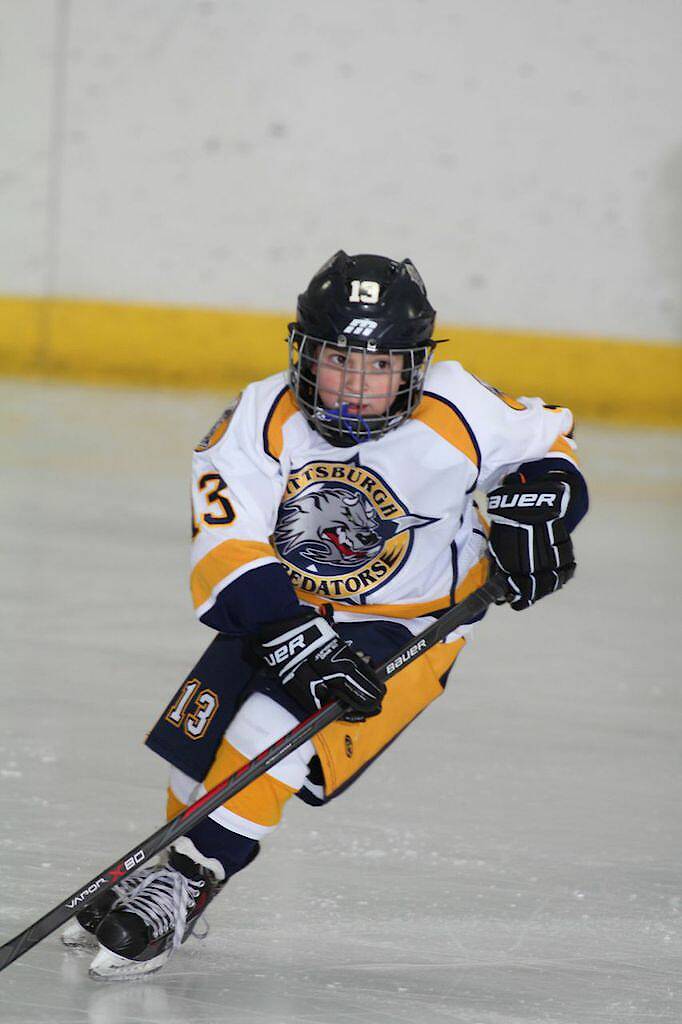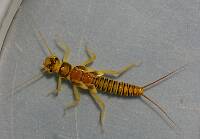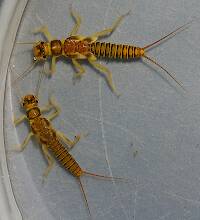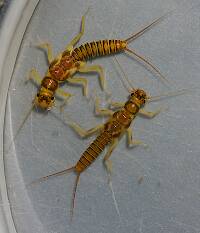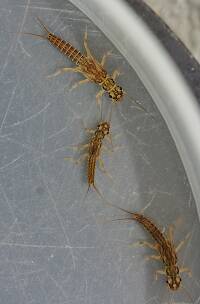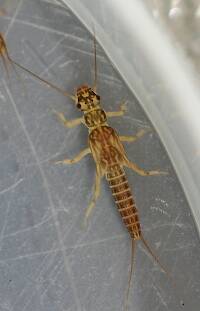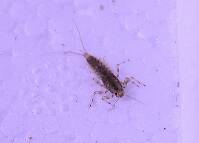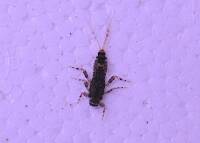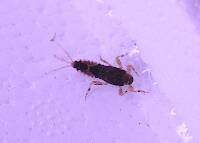
Blue-winged Olives
Baetis
Tiny Baetis mayflies are perhaps the most commonly encountered and imitated by anglers on all American trout streams due to their great abundance, widespread distribution, and trout-friendly emergence habits.
Featured on the forum

This species was fairly abundant in a February sample of the upper Yakima.

Troutnut is a project started in 2003 by salmonid ecologist Jason "Troutnut" Neuswanger to help anglers and
fly tyers unabashedly embrace the entomological side of the sport. Learn more about Troutnut or
support the project for an enhanced experience here.
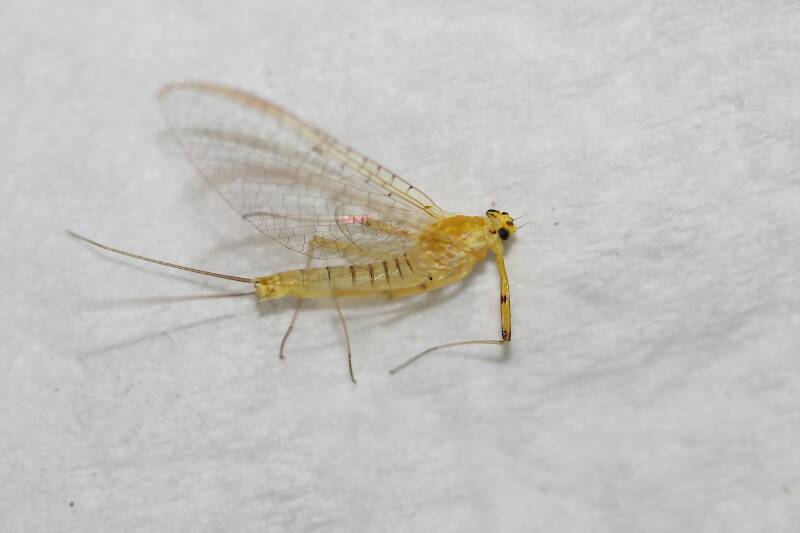
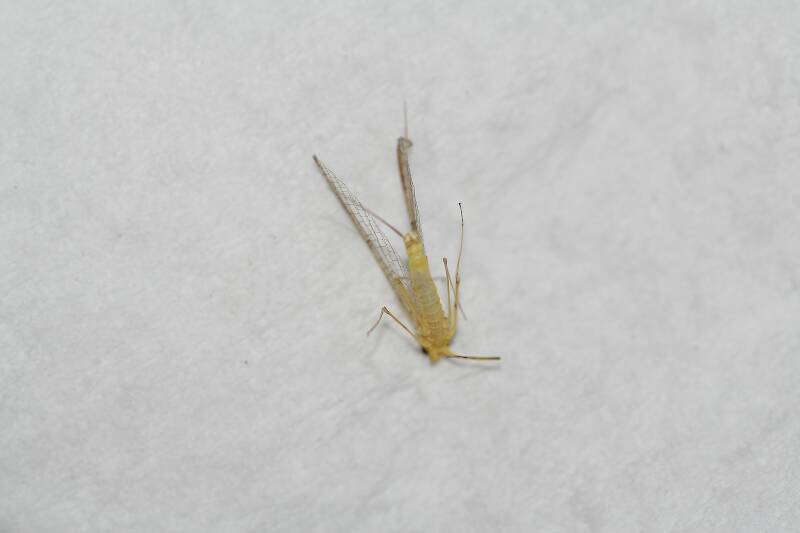
Shawnny3 on Jun 25, 2012June 25th, 2012, 8:08 am EDT
I saw several of these guys, pretty big (size 12), on a small stream. At first I thought it was a sulfur, but I noticed only two tails. Thoughts from those who use more than colors for ID's?
Thanks,
Shawn
Thanks,
Shawn
Jewelry-Quality Artistic Salmon Flies, by Shawn Davis
www.davisflydesigns.com
www.davisflydesigns.com
GONZO on Jun 25, 2012June 25th, 2012, 8:14 am EDT
Looks like Stenacron to me, Shawn.
Shawnny3 on Jun 26, 2012June 26th, 2012, 7:38 am EDT
I always thought of cahills as being cream-colored, but this guy was really bright yellow. Would it be a fair simplification to say that mayflies in this size and color are likely invaria if they have three tails and stenacron if they have two?
-Shawn
-Shawn
Jewelry-Quality Artistic Salmon Flies, by Shawn Davis
www.davisflydesigns.com
www.davisflydesigns.com
Entoman on Jun 26, 2012June 26th, 2012, 9:44 am EDT
I guess you could say that but like all generalities, there are a fair amount of exceptions. It's my understanding that besides these two, there are other fishable hatches of eastern heptageniids and ephemerellids that may overlap in size range that can be yellowish as well. That's definitely the case out West. Besides tail counts there are also significant differences in wing color and markings that should be taken into account.
"It's not that I find fishing so important, it's just that I find all other endeavors of Man equally unimportant... And not nearly as much fun!" Robert Traver, Anatomy of a Fisherman
Gutcutter on Jun 26, 2012June 26th, 2012, 12:17 pm EDT
Besides tail counts there are also significant differences in wing color and markings that should be taken into account.
My two cents, trying to blend mayfly I.D. with fishing:
You should also take into account the differences in hatching behavior. I see a light colored insect coming off of a stream that I know has both Cahills and invaria(or an unfamilar stream), and I watch them as they emerge and fly off of the water, from afar, no macro photos .
It is my experience that a "Cahill" sheds it's shuck very easily, but drifts forever on the surface as a dun, trying to get off of the water. Lots of hops, skips and jumps before it gets airborn.
The invaria, on the other hand, tend to stay in the surface struggling to get out of the shuck, and once free of it, take to the air almost immediately.
My Cahill patterns are either duns or wet flies, and a few spinners.
My invaria patterns, on the other hand, go from wet fly to floating nymph to ass down (half and half) emergers to flush emergers with trailing shuck to cripples to duns and the obligatory rusty spinners.
For this reason, I love fishing this hatch.
Comments?
All men who fish may in turn be divided into two parts: those who fish for trout and those who don't. Trout fishermen are a race apart: they are a dedicated crew- indolent, improvident, and quietly mad.
-Robert Traver, Trout Madness
-Robert Traver, Trout Madness
Jmd123 on Jun 26, 2012June 26th, 2012, 7:58 pm EDT
The Light Cahill hatch is one of my favorites too. There are streams in my area, particularily the Rifle River, which do not have any Hexagenia but I have seen nights in which the Light Cahills are coming off in such numbers that they bring every fish in the stream to the surface, just like a Hex hatch. My original fly-fishing mentor, who inspired me to fish the Hex hatch on the Maple River with him and thus turned me into a fly fisherman, used to call them "those little white ones" as they hatched around the same time. And on many nights, I did better by imitating them with a #10 or #12 White Wulff than I did on the actual Hex hatch itself!
This year has been weird, however - I have seen them hatching but nothing seems to be feeding on them. Yet, the other night on the Rifle, not seeing many Light Cahills at all, I pulled four nice fish out of the same hole on a #12 Light Cahill, two browns and two rainbows. I saw a fair number of them tonight, yet the fly of the evening was a #12 Royal Wulff, they were just tearing it up (literally, one sprung its hackle loose after several fish chewed it up pretty good). I am still waiting for a night when the Light Cahills really get the fish going - good thing this hatch lasts for a while...Got my biggest fish of the year so far, a 16" brown, on one a couple of weeks ago. Yep, I love 'em too.
Jonathon
This year has been weird, however - I have seen them hatching but nothing seems to be feeding on them. Yet, the other night on the Rifle, not seeing many Light Cahills at all, I pulled four nice fish out of the same hole on a #12 Light Cahill, two browns and two rainbows. I saw a fair number of them tonight, yet the fly of the evening was a #12 Royal Wulff, they were just tearing it up (literally, one sprung its hackle loose after several fish chewed it up pretty good). I am still waiting for a night when the Light Cahills really get the fish going - good thing this hatch lasts for a while...Got my biggest fish of the year so far, a 16" brown, on one a couple of weeks ago. Yep, I love 'em too.
Jonathon
No matter how big the one you just caught is, there's always a bigger one out there somewhere...
Oldredbarn on Jun 26, 2012June 26th, 2012, 8:23 pm EDT
My invaria patterns, on the other hand, go from wet fly to floating nymph to ass down (half and half) emergers to flush emergers with trailing shuck to cripples to duns and the obligatory rusty spinners.
For this reason, I love fishing this hatch.
Comments?
If it's invaria you love Tony, you need to be on the Au Sable with me next May! I have told these tales here before but I was floating with a friend on the South Branch years back and we had such a massive hatch it was ridiculous...Duns on our hats, on our rods, all over the boat, and when my fly hit the water there were two naturals in front of it and three riding right behind!
One evening I saw what I thought was fog only to realize it was a monster "cloud" of Light Henny spinners.
Enough said.
Spence
"Even when my best efforts fail it's a satisfying challenge, and that, after all, is the essence of fly fishing." -Chauncy Lively
"Envy not the man who lives beside the river, but the man the river flows through." Joseph T Heywood
"Envy not the man who lives beside the river, but the man the river flows through." Joseph T Heywood
Konchu on Jun 27, 2012June 27th, 2012, 7:57 pm EDT
The invaria, on the other hand, tend to stay in the surface struggling to get out of the shuck, and once free of it, take to the air almost immediately.
This ties in nicely with the Spinners & Cripples thread.
Quick Reply
Related Discussions
Topic
Replies
Last Reply
0
May 6, 2011
by Jtberez
by Jtberez
1
Aug 21, 2007
by Gene
by Gene
4
May 11, 2017
by Millcreek
by Millcreek
1
Mar 9, 2012
by Wiflyfisher
by Wiflyfisher



